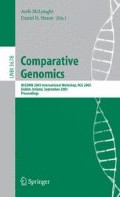Abstract
Whether common ancestors of eukaryotes and prokaryotes had introns is one of the oldest unanswered questions in molecular evolution. Recently completed genome sequences have been used for comprehensive analyses of exon-intron organization in orthologous genes of diverse organisms, leading to more refined work on intron evolution. Large sets of intron presence-absence data require rigorous theoretical frameworks in which different hypotheses can be compared and validated. We describe a probabilistic model for intron gains and losses along an evolutionary tree. The model parameters are estimated using maximum likelihood. We propose a method for estimating the number of introns lost or unobserved in all extant organisms in a study, and show how to calculate counts of intron gains and losses along the branches by using posterior probabilities. The methods are used to analyze the most comprehensive intron data set available presently, consisting of 7236 intron sites from eight eukaryotic organisms. The analysis shows a dynamic history with frequent intron losses and gains, and fairly — albeit not as greatly as previously postulated — intron-rich ancestral organisms.
Access this chapter
Tax calculation will be finalised at checkout
Purchases are for personal use only
Preview
Unable to display preview. Download preview PDF.
References
Crick, W.: Split genes and RNA splicing. Science 204, 264–271 (1979)
Lynch, M., Richardson, A.O.: The evolution of spliceosomal introns. Current Opinion in Genetics and Development 12, 701–710 (2002)
de Souza, S.J.: The emergence of a synthetic theory of intron evolution. Genetica 118, 117–121 (2003)
Rogozin, I.B., Wolf, Y.I., Sorokin, A.V., Mirkin, B.G., Koonin, E.V.: Remarkable interkingdom conservation of intron positions and massive, lineage-specific intron loss and gain in eukaryotic evolution. Current Biology 13, 1512–1517 (2003)
Qiu, W.G., Schisler, N., Stoltzfus, A.: The evolutionary gain of spliceosomal introns: Sequence and phase preferences. Molecular Biology and Evolution 21, 1252–1263 (2004)
Nielsen, C.B., Friendman, B., Birren, B., Burge, C.B., Galagan, J.E.: Patterns of intron gain and loss in fungi. PLoS Biology 2, e422 (2004)
Coghlan, A., Wolfe, K.H.: Origins of recently gained introns in Caenorhabditis. Proceedings of the National Academy of Sciences of the USA 101, 11362–11367 (2004)
Vaňáčová, Š., Yan, W., Carlton, J.M., Johnson, P.J.: Spliceosomal introns in the deep-branching eukaryote Trichomonas vaginalis. Proceedings of the National Academy of Sciences of the USA 102, 4430–4435 (2005)
Ross, S.M.: Stochastic Processes, 2nd edn. Wiley & Sons, Chichester (1996)
Rzhetsky, A., Ayala, F.J., Hsu, L.C., Chang, C., Yoshida, A.: Exon/intron structure of aldehyde dehydrogenase genes supports the “introns-late” theory. Proceedings of the National Academy of Sciences of the USA 94, 6820–6825 (1997)
Rogozin, I.B., Lyons-Weiler, J., Koonin, E.W.: Intron sliding in conserved gene families. Trends in Genetics 16, 430–432 (2000)
Felsenstein, J.: Inferring Pylogenies. Sinauer Associates, Sunderland (2004)
Tuffley, C., Steel, M.: Links between maximum likelihood and maximum parsimony under a simple model of site substitution. Bulletin of Mathematical Biology 59, 581–607 (1997)
Roch, S.: A short proof that phylogenetic reconstruction by maximum likelihood is hard. Technical report (2005), math.PR/0504378atarXiv.org
Chor, B., Tuller, T.: Maximum likelihood of evolutionary trees is hard. In: Proc. Ninth Annual International Conference on Research in Computational Biology (RECOMB) (2005) (in press)
Roy, S.W., Gilbert, W.: Complex early genes. Proceedings of the National Academy of Sciences of the USA 102, 1986–1991 (2005)
Roy, S.W., Gilbert, W.: Rates of intron loss and gain: Implications for early eukaryotic evolution. Proceedings of the National Academy of Sciences of the USA 102, 5773–5778 (2005)
Sverdlov, A.V., Rogozin, I.B., Babenko, V.N., Koonin, E.V.: Conservation versus parallel gains in intron evolution. Nucleic Acids Research 33, 1741–1748 (2005)
Koshi, J.M., Goldstein, R.A.: Probabilistic reconstruction of ancestral protein sequences. Journal of Molecular Evolution 42, 313–320 (1996)
Wolf, Y.I., Rogozin, I.B., Koonin, E.V.: Coelomata and not Ecdysozoa: Evidence from genome-wide phylogenetic analysis. Genome Research 14, 29–36 (2004)
Roy, S.W., Gilbert, W.: Resolution of a deep animal divergence by the pattern of intron conservation. Proceedings of the National Academy of Sciences of the USA 102, 4403–4408 (2005)
Philippe, H., Lartillot, N., Brinkmann, H.: Multigene analyses of bilaterian animals corroborate the monophyly of Ecdysozoa, Lophotrochozoa, and Protostomia. Molecular Biology and Evolution 22, 1246–1253 (2005)
Philip, G.K., Creevey, C.J., McInerney, J.O.: The Opisthokonta and the Ecdysozoa may not be clades: Stronger support for the grouping of plant and animal than for animal and fungi and stronger support for the Coelomata than Ecdysozoa. Molecular Biology and Evolution 22, 1175–1184 (2005)
Le Quesne, W.J.: The uniquely evolved character concept and its cladistic application. Systematic Zoology 23, 513–517 (1974)
Farris, J.S.: Phylogenetic analysis under Dollo’s law. Systematic Zoology 26, 77–88 (1977)
Author information
Authors and Affiliations
Editor information
Editors and Affiliations
Rights and permissions
Copyright information
© 2005 Springer-Verlag Berlin Heidelberg
About this paper
Cite this paper
Csűrös, M. (2005). Likely Scenarios of Intron Evolution. In: McLysaght, A., Huson, D.H. (eds) Comparative Genomics. RCG 2005. Lecture Notes in Computer Science(), vol 3678. Springer, Berlin, Heidelberg. https://doi.org/10.1007/11554714_5
Download citation
DOI: https://doi.org/10.1007/11554714_5
Publisher Name: Springer, Berlin, Heidelberg
Print ISBN: 978-3-540-28932-6
Online ISBN: 978-3-540-31814-9
eBook Packages: Computer ScienceComputer Science (R0)

